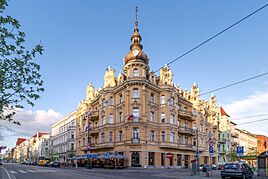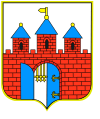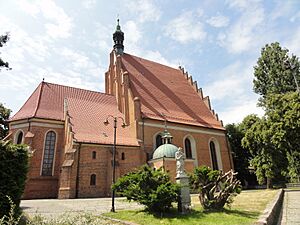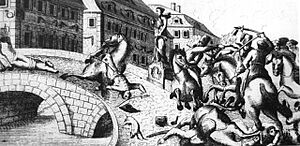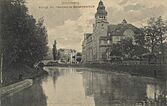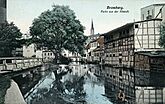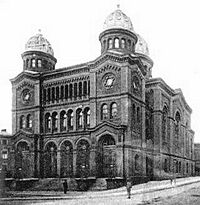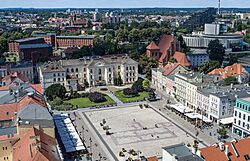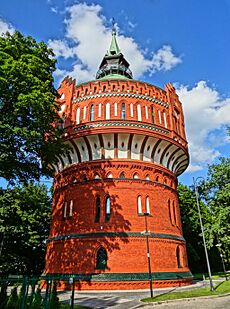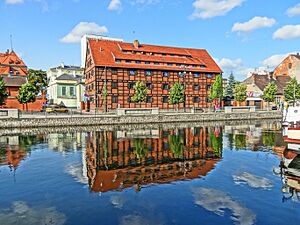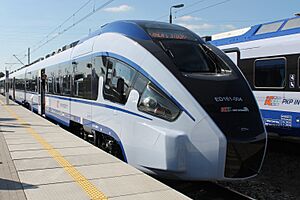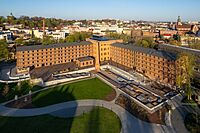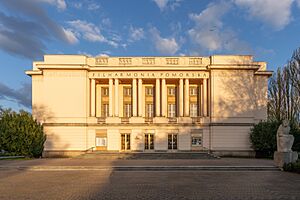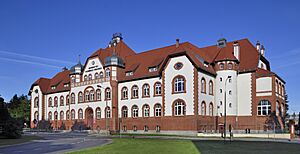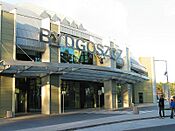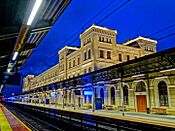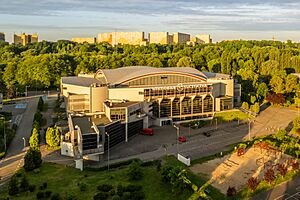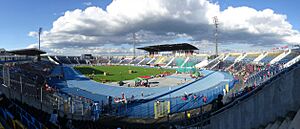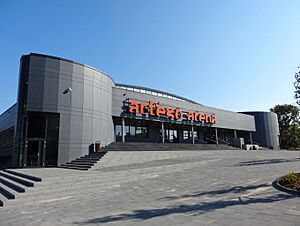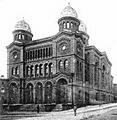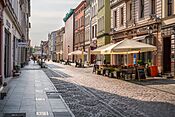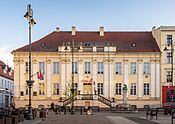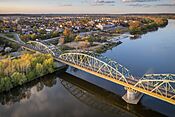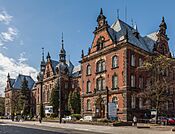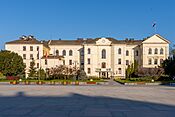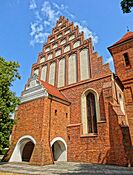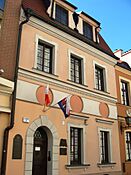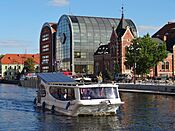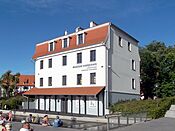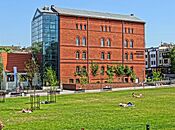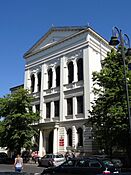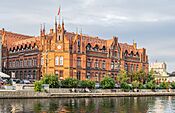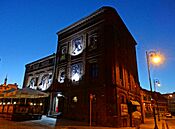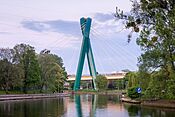Bydgoszcz facts for kids
Quick facts for kids
Bydgoszcz
|
|||||
|---|---|---|---|---|---|
|
City county
|
|||||
|
Downtown with Freedom Square
Old Market Square
Main Post Office
Opera Nova seen from Mill Island
St Martin's and St Nicholas' Cathedral
Banks of the Brda River in the Old Town
|
|||||
|
|||||
| Nickname(s):
Little Berlin
|
|||||
| Country | |||||
| Voivodeship | Kuyavian-Pomeranian | ||||
| County | city county | ||||
| Established | before 1238 | ||||
| City rights | 1346 | ||||
| Government | |||||
| • Body | Bydgoszcz City Council | ||||
| Area | |||||
| • Total | 176 km2 (68 sq mi) | ||||
| Elevation | 60 m (200 ft) | ||||
| Population
(31 December 2022)
|
|||||
| • Total | 330,038 |
||||
| • Density | 1,875/km2 (4,860/sq mi) | ||||
| GDP | |||||
| • Bydgoszcz–Toruń metropolitan area | €10.871 billion (2020) | ||||
| Time zone | UTC+1 (CET) | ||||
| • Summer (DST) | UTC+2 (CEST) | ||||
| Postal code |
85-001 to 85–915
|
||||
| Area code(s) | (+48) 52 | ||||
| Car plates | CB | ||||
| Primary airport | Bydgoszcz Ignacy Jan Paderewski Airport | ||||
| Highways | |||||
Bydgoszcz is a cool city in northern Poland. It's the biggest city in the historical region of Kuyavia. The city sits where the Vistula River meets its branch, the Brda. This special spot made Bydgoszcz an important port and a busy place for trade and transport.
With over 330,000 people, Bydgoszcz is the eighth-largest city in Poland. It's one of the two capitals of the Kuyavian-Pomeranian Voivodeship. The wider area around Bydgoszcz has about half a million people. It's also part of a bigger area with Toruń, where about 800,000 people live.
For a long time, Bydgoszcz was a "royal city" in Poland. It grew a lot during the Industrial Revolution, especially after the Bydgoszcz Canal was built in the late 1700s. Today, Bydgoszcz is home to several universities and music schools. It's also the biggest center for NATO headquarters in Poland. The city has an international airport and is part of Eurocities, a network of major European cities.
Bydgoszcz is famous for its beautiful buildings, which mix old styles like Gothic and Baroque with newer ones like Art Nouveau. Because of its architecture and many green spaces, people sometimes call it Little Berlin. The old granaries on Mill Island are some of the most famous wooden buildings in Poland. In 2023, Bydgoszcz became a UNESCO Creative Cities Network member and was named a UNESCO City of Music.
Contents
What's in a Name?
The name Bydgoszcz comes from an old Polish name, Bydgost. The German name for the city, Bromberg, means "hill on the Brahe River," which is the Brda River.
A Look Back in Time
Early Days and First Homes
Long ago, Bydgoszcz was a busy place for trade. It was on the Amber Road, a path used to trade amber all the way to the Roman Empire. This made it a good spot for a fishing village called Bydgoszcza.
Around 1037 to 1053, a strong fort was built here. In the 1200s, Bydgoszcz had a special officer called a castellan. The first church, Saint Giles, was built in the 13th century. The first bridge was also built around this time.
In the early 1300s, Bydgoszcz became the capital of a small duchy. But in 1330, the city was attacked and destroyed by the Teutonic Knights. They took it over for a few years, calling it Bromberg. Poland got it back in 1337, and it was officially returned in 1343.
A Royal Polish City
On April 19, 1346, King Casimir III of Poland gave Bydgoszcz special city rights. This meant it could grow and trade more easily. The king also ordered a castle to be built. Bydgoszcz became an important royal city in Poland.
Many Jewish people moved to the city after this. In 1555, they were asked to leave but returned much later in 1772. The king's grandson, Duke Casimir IV, loved staying at Bydgoszcz castle. In 1397, a Carmelite convent was built thanks to Queen Jadwiga of Poland.
During a war in 1409, the Teutonic Knights briefly captured the city again. In the mid-1400s, King Casimir IV of Poland often visited Bydgoszcz. During this time, defensive walls were built, and the beautiful Gothic church (now the Bydgoszcz Cathedral) was constructed. The city grew strong from river trade. Bydgoszcz's pottery and beer were very popular. It also became a major center for trading wheat. The first school here was mentioned in 1466.
In 1480, a Bernardine monastery was built, which had a library. In 1594, a private mint started making coins, which later became a royal mint, one of the best in Poland. In 1621, a very valuable coin was made in Bydgoszcz to celebrate a Polish victory. In 1617, the Jesuits came and started a college.
In the 1600s, Bydgoszcz was attacked and damaged by Swedish troops during wars. The castle was completely destroyed and became a ruin. After these wars, many houses were empty or burned down.
In 1657, the Treaty of Bromberg was signed here, creating an alliance between Poland and Prussia. In 1764, Bydgoszcz became one of the main courts for a large part of Poland. A plan to build a canal connecting the Vistula and Noteć rivers was proposed in 1766. Józef Wybicki, who wrote the Polish national anthem, worked in Bydgoszcz.
Modern Times
In 1772, during the First Partition of Poland, Bydgoszcz became part of Prussia and was called Bromberg. The city was in bad shape, but under King Frederick the Great, it started to grow again. A very important canal was built, connecting the Vistula and Oder rivers. This helped the city's industry. Many people in the city spoke German, and its architecture reminded some of Berlin, earning it the nickname "little Berlin." In 1794, during the Kościuszko Uprising, Polish forces briefly took the city back.
In 1807, after Napoleon's wars, Bydgoszcz became part of the Polish Duchy of Warsaw. But in 1813, it returned to Prussia. During the November Uprising, Polish groups in the city helped smuggle weapons. In 1871, Bydgoszcz became part of the new German Empire. During this time, some old churches and the castle ruins were sadly torn down. The Prussian Eastern Railway arrived in 1851, connecting Bydgoszcz to other cities.
Before World War I, Poles in Bydgoszcz secretly planned to get their city back if Poland became independent.
Between the World Wars
After World War I, the Versailles Treaty gave Bydgoszcz back to Poland in 1919. The city's borders grew a lot in 1920, making it the third-largest city in Poland by area. In 1938, it became part of the Greater Pomerania region of Poland.
World War II
During World War II, on September 1, 1939, Germany attacked Bydgoszcz from the air. Polish soldiers fought bravely but had to retreat. As Poles left, some local Germans opened fire on Polish soldiers and civilians. This led to fighting where many people were killed. Nazi German propaganda called this event "Bloody Sunday" and used it as an excuse to kill many Polish residents.
On September 5, German forces entered the city, and the German occupation began. German special units came to commit terrible acts against the Polish people. Many Poles were killed, especially educated people, to stop any resistance. On September 24, German officials tricked Polish city leaders into a meeting, then took them to a forest and killed them. Their families were also killed.
The Germans set up prisons and camps for Poles. Thousands were arrested, and many were murdered in the city or nearby areas. Victims included teachers, priests, officials, and even children as young as 12. The mayor of Bydgoszcz was publicly executed on Polish Independence Day in 1939. Around 10,000 people, mostly Poles and Polish Jews, were killed during the war. The city's Jewish community was destroyed, with many sent to camps or murdered. A women's subcamp of the Stutthof concentration camp was in Bydgoszcz. Polish children were also sent from camps to Bydgoszcz for forced labor.
During the occupation, the Germans destroyed some historic buildings to build new ones. They also built a huge secret dynamite factory hidden in a forest, using forced labor. Polish resistance groups were active in Bydgoszcz, distributing secret newspapers, doing sabotage, and helping British prisoners of war.
In spring 1945, the Red Army took Bydgoszcz. German residents who survived were sent away, and the city was returned to Poland.
After the War
In 1945, Bydgoszcz became the capital of the Pomeranian Voivodship, which was later renamed the Bydgoszcz Voivodeship. New universities were founded in 1951 and 1969. In 1973, the town of Fordon became part of Bydgoszcz. In 1981, Solidarity activists faced harsh treatment in Bydgoszcz.
Since 1999, Bydgoszcz has been the seat of the governor for the Kuyavian-Pomeranian Voivodeship. In 2005, Casimir the Great University opened. Today, Bydgoszcz is the biggest center for NATO headquarters in Poland, including the Joint Force Training Centre.
Cool Places to See
The oldest building in Bydgoszcz is the Cathedral of St Martin and St Nicolas, also called Fara Church. It's a beautiful Gothic church built between 1466 and 1502. It has a famous painting called Madonna with a Rose from the 1500s.
The Church of the Assumption of the Holy Virgin is another famous spot. It's a Gothic-Renaissance church built between 1582 and 1602. Even though it was used as a warehouse in the past, its original wooden ceiling from the 1600s is amazing!
Wyspa Młyńska (Mill Island) is one of the most special places in Bydgoszcz. It's right in the city center, near the Old Market Square. This island was once the city's industrial heart, and the royal mint operated here in the 1600s. Most buildings are from the 1800s, but the Biały Spichlerz (White Granary) is even older. The water, bridges, old red-brick houses, and green trees make it a truly unique place.
The "Hotel pod Orłem" (The Eagle Hotel) is a famous 19th-century building. It was designed by a well-known Bydgoszcz architect, Józef Święcicki, and finished in 1896. Its design shows the Neo-baroque style.
Saint Vincent de Paul's Basilica, built from 1925 to 1939, is the biggest church in Bydgoszcz and one of the largest in Poland. It can hold about 12,000 people! This huge church looks like the Pantheon in Rome. Its most striking feature is the large concrete dome, 40 meters wide.
The three granaries on Grodzka Street are a symbol of the city. They are right by the Brda River, near the Old Market Square. Built around the 1800s, they used to store grain. Now, they are part of the city's museum.
The old building of the Prussian Eastern Railway Headquarters is another cool structure. It was built between 1886 and 1889.
Bydgoszcz is known for its water, sports, beautiful buildings, music, and green spaces. It has the largest city park in Poland, covering 830 hectares!
City Life and People
Bydgoszcz has many banks and insurance companies. Big companies like JP Morgan Chase have offices here. There are also large industrial areas, like the 'Zachem' chemical works, which was once a secret German explosives factory during World War II. Now, part of it is an open-air museum called Exploseum.
Since 2001, Bydgoszcz has been getting good ratings for its economy. In 2004, the city opened an Industrial and Technology Park. This park offers tax breaks and other benefits to companies that move there, making it a good place for business.
How Bydgoszcz Grew

Arts and Fun
Bydgoszcz is a big center for culture, especially music! There have been theaters here since the 1600s. The first music school opened in 1904. Many orchestras and choirs have called Bydgoszcz home. Since 1974, the city has had a very respected Academy of Music. Bydgoszcz is also known for jazz music, with the famous Brain club.
Bydgoszcz was even a candidate for the title of European Capital of Culture in 2016. In 2023, UNESCO named it a City of Music.
Museums to Explore
The Leon Wyczółkowski District Museum is a city-owned museum. It has a large collection of works by Leon Wyczółkowski and other art exhibits. It's spread across several buildings, including the old granaries on the Brda River and Mill Island. The Exploseum, a museum built inside an old World War II munitions factory, is also part of it.
The Pomeranian Military Museum focuses on Polish military history from the 1800s and 1900s.
The city has many art galleries, two symphony orchestras, and many choirs. Bydgoszcz also has great libraries, including the Provincial and Municipal Public Library with old books. Near the city, the Palaces and park ensemble in Ostromecko has one of Poland's largest collections of historical pianos.
Music and Theatre
The Pomeranian Philharmonic, named after Ignacy Paderewski, has an amazing concert hall. It's known as one of the best in Europe for its sound quality! Many famous musicians from around the world have performed here.
The Teatr Polski offers many different shows. It also hosts the "Festiwal Prapremier," where top Polish theaters show their newest plays.
The Opera Nova has been around since 1956. Its new building, started in 1974, is a cultural highlight of Bydgoszcz. Many famous opera singers and theater groups have performed here.
Movies
Bydgoszcz hosts the CAMERIMAGE International Film Festival. This festival celebrates cinematography and the talented people who create the look of films.
Learning in Bydgoszcz
Bydgoszcz has several universities and colleges:
- Kazimierz Wielki University
- University of Technology and Life Sciences in Bydgoszcz
- Bydgoszcz Music Academy - "Feliks Nowowiejski"
- Medical College of Nicolaus Copernicus University
- WSB Merito University in Toruń (Finance and Management department)
- Wyższa Szkoła Gospodarki (University of Economics)
Getting Around
Airports
- Bydgoszcz Ignacy Jan Paderewski Airport
Trains
Bydgoszcz is a major train hub in Poland. Important train lines cross here, connecting the east and west, and the north and south. Some train stations in the city include:
- Bydgoszcz Główna – the main station
- Bydgoszcz Leśna
- Bydgoszcz Wschód
- Bydgoszcz Zachód
- Bydgoszcz Fordon
Buses and Trams
Local buses and trams help people get around the city. There are also inter-city and international bus routes.
Sports Fun
Bydgoszcz is home to many sports teams and facilities!
Sports Teams
- Basket 25 Bydgoszcz – a women's basketball team.
- Astoria Bydgoszcz – a men's basketball team.
- Bydgoszcz Archers – an American football team.
- Pałac Bydgoszcz – a women's volleyball team.
- BKS Visła Bydgoszcz – a men's volleyball team.
- KKP Bydgoszcz – a women's football (soccer) team.
- Polonia Bydgoszcz – a famous speedway (motorcycle racing) team and a football team.
- Zawisza Bydgoszcz – a football team.
- RTW Bydgostia Bydgoszcz – a very successful rowing club.
- Gwiazda Bydgoszcz – a men's table tennis team.
Sports Places
- Łuczniczka – a big arena for sports and events.
- Sisu Arena – an indoor sports arena.
- Zdzisław Krzyszkowiak Stadium – a large stadium.
- Polonia Stadium – another stadium.
- Hala Torbyd – an indoor arena.
Sports Events
Bydgoszcz has hosted many international sports events, including:
- Athletics championships (like the World Junior Championships)
- Speedway Grand Prix races
- Basketball (Eurobasket 2009)
- Women's European Volleyball Championships 2009
- FIFA U-20 World Cup in 2019
Friends Around the World
Consulates
Bydgoszcz has honorary consulates for several countries, including Austria, Belgium, Croatia, Czech Republic, Germany, Hungary, Montenegro, Serbia, Slovakia, and Ukraine.
Sister Cities
Bydgoszcz is friends with many cities around the world! These "twin towns" work together on cultural and educational projects.
| Twin Towns | ||
| City/Town | Country | Year |
|---|---|---|
| Reggio Emilia | 1962 | |
| Kragujevac | 1971 | |
| Mannheim | 1991 | |
| Hartford | 1996 | |
| Pavlodar | 1997 | |
| Perth | 1998 | |
| Cherkasy | 2000 | |
| Kremenchuk | 2004 | |
| Patras | 2004 | |
| Ningbo | 2005 | |
| Wilhelmshaven | 2006 | |
| Pitești | 2007 | |
| Sliven | 2019 | |
Fun Legends
Did you know that the famous magician Pan Twardowski is said to have spent time in Bydgoszcz? Today, you can see a figure of him in a window in the Old Town! At 1:13 p.m. and 9:13 p.m., the window opens, and Pan Twardowski appears with spooky music and laughter. He bows, waves, and then disappears. It's a fun show that many people come to watch!
Images for kids
Gallery
-
School of mechanics (secondary education)
Weather in Bydgoszcz
Bydgoszcz has a humid continental climate, which means it has warm summers and cold winters.
| Climate data for Bydgoszcz (1991–2020 normals, extremes 1951–1982 and 1992–2015) | |||||||||||||
|---|---|---|---|---|---|---|---|---|---|---|---|---|---|
| Month | Jan | Feb | Mar | Apr | May | Jun | Jul | Aug | Sep | Oct | Nov | Dec | Year |
| Record high °C (°F) | 13.0 (55.4) |
14.1 (57.4) |
22.8 (73.0) |
30.7 (87.3) |
31.9 (89.4) |
35.5 (95.9) |
38.3 (100.9) |
37.0 (98.6) |
33.4 (92.1) |
28.2 (82.8) |
19.5 (67.1) |
15.9 (60.6) |
38.3 (100.9) |
| Mean maximum °C (°F) | 8.2 (46.8) |
9.4 (48.9) |
15.7 (60.3) |
23.3 (73.9) |
27.5 (81.5) |
30.6 (87.1) |
31.7 (89.1) |
31.1 (88.0) |
25.5 (77.9) |
20.0 (68.0) |
13.1 (55.6) |
8.8 (47.8) |
33.1 (91.6) |
| Mean daily maximum °C (°F) | 1.1 (34.0) |
2.7 (36.9) |
6.9 (44.4) |
14.1 (57.4) |
19.4 (66.9) |
22.1 (71.8) |
24.6 (76.3) |
23.9 (75.0) |
18.6 (65.5) |
12.7 (54.9) |
6.2 (43.2) |
2.0 (35.6) |
12.9 (55.2) |
| Daily mean °C (°F) | −1.5 (29.3) |
−0.4 (31.3) |
2.5 (36.5) |
8.5 (47.3) |
13.7 (56.7) |
16.7 (62.1) |
19.1 (66.4) |
18.2 (64.8) |
13.3 (55.9) |
8.2 (46.8) |
3.5 (38.3) |
−0.3 (31.5) |
8.5 (47.2) |
| Mean daily minimum °C (°F) | −3.7 (25.3) |
−3.0 (26.6) |
−0.8 (30.6) |
3.5 (38.3) |
8.1 (46.6) |
11.2 (52.2) |
13.7 (56.7) |
13.1 (55.6) |
9.3 (48.7) |
5.1 (41.2) |
1.3 (34.3) |
−2.4 (27.7) |
4.6 (40.3) |
| Mean minimum °C (°F) | −14.9 (5.2) |
−12.4 (9.7) |
−8.3 (17.1) |
−3.1 (26.4) |
0.9 (33.6) |
5.6 (42.1) |
8.8 (47.8) |
7.6 (45.7) |
2.7 (36.9) |
−2.3 (27.9) |
−5.9 (21.4) |
−11.7 (10.9) |
−18.3 (−0.9) |
| Record low °C (°F) | −29.9 (−21.8) |
−26.6 (−15.9) |
−25.4 (−13.7) |
−8.5 (16.7) |
−5.1 (22.8) |
−1.8 (28.8) |
2.5 (36.5) |
1.9 (35.4) |
−4.0 (24.8) |
−8.3 (17.1) |
−19.6 (−3.3) |
−24.2 (−11.6) |
−29.9 (−21.8) |
| Average precipitation mm (inches) | 34.3 (1.35) |
26.3 (1.04) |
36.4 (1.43) |
28.2 (1.11) |
52.8 (2.08) |
56.7 (2.23) |
83.4 (3.28) |
55.6 (2.19) |
48.0 (1.89) |
40.1 (1.58) |
33.6 (1.32) |
36.9 (1.45) |
532.3 (20.95) |
| Average precipitation days (≥ 0.1 mm) | 16.0 | 13.4 | 12.9 | 10.5 | 12.4 | 12.4 | 14.2 | 12.0 | 10.9 | 12.7 | 13.7 | 16.9 | 158.4 |
| Average relative humidity (%) | 86.8 | 86.6 | 81.4 | 71.5 | 69.7 | 71.1 | 73.6 | 75.4 | 81.7 | 86.3 | 90.5 | 89.3 | 80.3 |
| Average dew point °C (°F) | −4 (25) |
−3 (27) |
−1 (30) |
2 (36) |
7 (45) |
10 (50) |
13 (55) |
13 (55) |
10 (50) |
6 (43) |
3 (37) |
−1 (30) |
5 (40) |
| Source 1: Meteomodel.pl | |||||||||||||
| Source 2: Time and Date (dewpoints, 2005-2015) | |||||||||||||
Famous People from Bydgoszcz
Many interesting people were born in Bydgoszcz, including:
- Maximilian Piotrowski (1813–1875), a painter.
- Marian Rejewski (1905–1980), a mathematician and cryptologist who helped break the Enigma code.
- Zbigniew Boniek (born 1956), a famous football (soccer) player.
- Radosław Sikorski (born 1963), a politician.
- Paweł Wojciechowski (born 1989), a pole vaulter.
- Przemek Karnowski (born 1993), a basketball player.
- Helena Wiśniewska (born 1999), a sprint canoeist.
See also
 In Spanish: Bydgoszcz para niños
In Spanish: Bydgoszcz para niños


